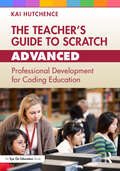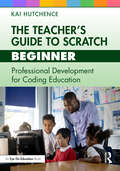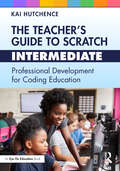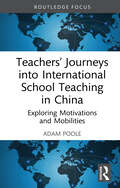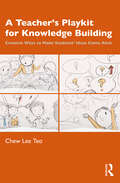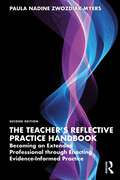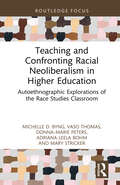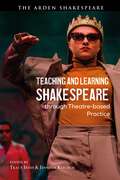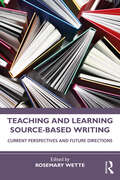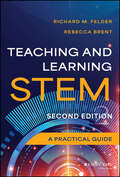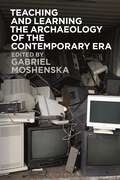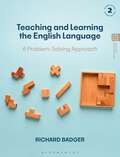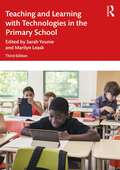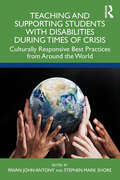- Table View
- List View
The Teacher’s Guide to Scratch – Advanced: Professional Development for Coding Education
by Kai HutchenceThe Teacher’s Guide to Scratch – Advanced is a practical guide for educators preparing sophisticated coding lessons and assignments in their K–12 classrooms. The world’s largest and most active visual programming platform, Scratch helps today’s schools answer the growing call to realize important learning outcomes using coding and computer science. This book illustrates the expert-level potential of Scratch coding, details effective pedagogical strategies and learner collaborations, and offers actionable, accessible troubleshooting tips. Geared toward the advanced user, these four unique coding projects will provide the technical training that teachers need to master Scratch, feeling comfortable and confident in their skills as they unlock the program’s full potential for themselves and their students. Clear goals, a comprehensive glossary, and other features ensure the project’s enduring relevance as a reference work for computer science education in grade school. Thanks to Scratch’s cost-effective open-source license, suitability for blended and project-based learning, notable lack of privacy or security risks, and consistency in format even amid software and interface updates, this will be an enduring practitioner manual and professional development resource for years to come.
The Teacher’s Guide to Scratch – Beginner: Professional Development for Coding Education
by Kai HutchenceThe Teacher’s Guide to Scratch – Beginner is a practical guide for educators preparing beginners-level coding lessons and assignments in their K–12 classrooms. The world’s largest and most active visual programming platform, Scratch helps today’s schools answer the growing call to realize important learning outcomes using coding and computer science. This book illustrates the benefits and fundamental building blocks of Scratch coding, details effective pedagogical strategies and learner collaborations, and offers actionable, accessible troubleshooting tips. Geared toward the fledgling user, these four unique coding projects will provide the technical training that teachers need to feel comfortable and confident in their skills and to help instill the same feeling of accomplishment in their students. Clear goals, a comprehensive glossary, and other features ensure the project’s enduring relevance as a reference work for computer science education in grade school. Thanks to Scratch’s cost-effective open-source license, suitability for blended and project-based learning, notable lack of privacy or security risks, and consistency in format even amid software and interface updates, this will be an enduring practitioner manual and professional development resource for years to come.
The Teacher’s Guide to Scratch – Beginner: Professional Development for Coding Education
by Kai HutchenceThe Teacher’s Guide to Scratch – Beginner is a practical guide for educators preparing beginners-level coding lessons and assignments in their K–12 classrooms. The world’s largest and most active visual programming platform, Scratch helps today’s schools answer the growing call to realize important learning outcomes using coding and computer science. This book illustrates the benefits and fundamental building blocks of Scratch coding, details effective pedagogical strategies and learner collaborations, and offers actionable, accessible troubleshooting tips. Geared toward the fledgling user, these four unique coding projects will provide the technical training that teachers need to feel comfortable and confident in their skills and to help instill the same feeling of accomplishment in their students. Clear goals, a comprehensive glossary, and other features ensure the project’s enduring relevance as a reference work for computer science education in grade school. Thanks to Scratch’s cost-effective open-source license, suitability for blended and project-based learning, notable lack of privacy or security risks, and consistency in format even amid software and interface updates, this will be an enduring practitioner manual and professional development resource for years to come.
The Teacher’s Guide to Scratch – Intermediate: Professional Development for Coding Education
by Kai HutchenceThe Teacher’s Guide to Scratch – Intermediate is a practical guide for educators preparing moderately complex coding lessons and assignments in their K-12 classrooms. The world’s largest and most active visual programming platform, Scratch helps today’s schools answer the growing call to realize important learning outcomes using coding and computer science. This book illustrates the increasingly intricate affordances of Scratch coding, details effective pedagogical strategies and learner collaborations, and offers actionable, accessible troubleshooting tips. Geared toward the intermediate user, these four unique coding projects will provide the technical training that teachers need to feel comfortable and confident in their skills and to help instill the same feeling of accomplishment in their students. Clear goals, a comprehensive glossary, and other features ensure the project’s enduring relevance as a reference work for computer science education in grade school. Thanks to Scratch’s cost-effective open-source license, suitability for blended and project-based learning, notable lack of privacy or security risks, and consistency in format even amid software and interface updates, this will be an enduring practitioner manual and professional development resource for years to come.
The Teacher’s Guide to Scratch – Intermediate: Professional Development for Coding Education
by Kai HutchenceThe Teacher’s Guide to Scratch – Intermediate is a practical guide for educators preparing moderately complex coding lessons and assignments in their K-12 classrooms. The world’s largest and most active visual programming platform, Scratch helps today’s schools answer the growing call to realize important learning outcomes using coding and computer science. This book illustrates the increasingly intricate affordances of Scratch coding, details effective pedagogical strategies and learner collaborations, and offers actionable, accessible troubleshooting tips. Geared toward the intermediate user, these four unique coding projects will provide the technical training that teachers need to feel comfortable and confident in their skills and to help instill the same feeling of accomplishment in their students. Clear goals, a comprehensive glossary, and other features ensure the project’s enduring relevance as a reference work for computer science education in grade school. Thanks to Scratch’s cost-effective open-source license, suitability for blended and project-based learning, notable lack of privacy or security risks, and consistency in format even amid software and interface updates, this will be an enduring practitioner manual and professional development resource for years to come.
Teachers’ Journeys into International School Teaching in China: Exploring Motivations and Mobilities (Routledge Series on Schools and Schooling in Asia)
by Adam PoolePoole’s book illuminates the experiences and perspectives of host country national teachers at internationalised schools in China. The international school sector in China has undergone significant changes in recent years. This is due to the growing demand for international education from local middle-class families. In response, a new type of school has emerged. Going by various names, such as private, bilingual or internationalised, these schools offer a fusion of national and international curricula and are staffed predominantly by host country national teachers. Despite these changes, we still know little about who host country national teachers are and what draws them to the world of international schooling. Accordingly, this book explores the motivations and mobilities of host country national teachers in China. It identifies three types of teacher: Returners, Reachers, and Remainers. Returners are graduates who have returned to China from overseas study. They are drawn to international schools by the opportunity to use their international experience and qualification. Reachers are internal migrants who face structural inequality and attracted to international schools by the opportunity for social mobility. Remainers are married teachers with children. They are motivated to work in international schools by the perceived stability and security these schools offer. Discussing implications for teacher recruitment, development, and retention in international schools, this book is an essential read for international educational researchers as well as students researching international education or teacher identity.
Teachers’ Journeys into International School Teaching in China: Exploring Motivations and Mobilities (Routledge Series on Schools and Schooling in Asia)
by Adam PoolePoole’s book illuminates the experiences and perspectives of host country national teachers at internationalised schools in China. The international school sector in China has undergone significant changes in recent years. This is due to the growing demand for international education from local middle-class families. In response, a new type of school has emerged. Going by various names, such as private, bilingual or internationalised, these schools offer a fusion of national and international curricula and are staffed predominantly by host country national teachers. Despite these changes, we still know little about who host country national teachers are and what draws them to the world of international schooling. Accordingly, this book explores the motivations and mobilities of host country national teachers in China. It identifies three types of teacher: Returners, Reachers, and Remainers. Returners are graduates who have returned to China from overseas study. They are drawn to international schools by the opportunity to use their international experience and qualification. Reachers are internal migrants who face structural inequality and attracted to international schools by the opportunity for social mobility. Remainers are married teachers with children. They are motivated to work in international schools by the perceived stability and security these schools offer. Discussing implications for teacher recruitment, development, and retention in international schools, this book is an essential read for international educational researchers as well as students researching international education or teacher identity.
A Teacher’s Playkit for Knowledge Building: Creative Ways to Make Students’ Ideas Come Alive
by Chew Lee TeoDelving into the journey of teachers and students in the knowledge building classroom, Teo’s playkit offers practical approaches to making classrooms a place of knowledge creation.Teo highlights the potential and possibility of idea-centric discourse and interactions in Singapore’s high-performing education system while offering a trilogue among researchers, teachers and students: the agents of a knowledge building environment in classrooms. Documenting case examples of knowledge building lessons in relation to the curriculum design and pedagogical decisions and moves, as well as the formative assessment, the book focuses on those 21st-century practices embedded within the knowledge building process. It comprises a series of teachers’ journeys in different subjects and grades, demonstrating the depth and breadth of projects that students are capable of pursuing in class when they are entrusted to work with their own ideas and questions. It also offers a collection of concrete tools and strategies for teachers to use to support knowledge building work. The different case examples support teachers in their design effort and will encourage the community of researchers and educators to continue to imagine the possibilities of pedagogical educational reform.Written for practitioners, this playkit aims to engage the wider community of teachers to play with their own lesson ideas as they engage their students in knowledge creation.
A Teacher’s Playkit for Knowledge Building: Creative Ways to Make Students’ Ideas Come Alive
by Chew Lee TeoDelving into the journey of teachers and students in the knowledge building classroom, Teo’s playkit offers practical approaches to making classrooms a place of knowledge creation.Teo highlights the potential and possibility of idea-centric discourse and interactions in Singapore’s high-performing education system while offering a trilogue among researchers, teachers and students: the agents of a knowledge building environment in classrooms. Documenting case examples of knowledge building lessons in relation to the curriculum design and pedagogical decisions and moves, as well as the formative assessment, the book focuses on those 21st-century practices embedded within the knowledge building process. It comprises a series of teachers’ journeys in different subjects and grades, demonstrating the depth and breadth of projects that students are capable of pursuing in class when they are entrusted to work with their own ideas and questions. It also offers a collection of concrete tools and strategies for teachers to use to support knowledge building work. The different case examples support teachers in their design effort and will encourage the community of researchers and educators to continue to imagine the possibilities of pedagogical educational reform.Written for practitioners, this playkit aims to engage the wider community of teachers to play with their own lesson ideas as they engage their students in knowledge creation.
The Teacher's Reflective Practice Handbook: Becoming an Extended Professional through Enacting Evidence-Informed Practice
by Paula Nadine Zwozdiak-MyersThe Teacher’s Reflective Practice Handbook is based on a multi-dimensional framework of reflective practice designed by the author to guide and support student, early career and experienced teachers to develop high-quality teaching and maximise pupil learning. This second edition combines the intent to preserve the integrity of seminal contributions advanced by eminent scholars and practitioners over the years, with that of broadening its reach to reflect key changes in policy discourse, teacher education, school and curriculum reform underpinned by evidence-informed research on what constitutes effective teaching and learning, across the national and international landscape. Chapters invite you to engage in descriptive, comparative and critical reflective conversations across nine dimensions of reflective practice which enables you to: Question personal theories, beliefs and assumptions about teaching and consider alternative perspectives and possibilities Systematically evaluate your own teaching through classroom research procedures Try out new strategies and ideas to appropriate new knowledge and to tailor inclusive provision for all your learners Enhance the quality of and continue to improve your own teaching Including a range of reflective tasks, links to online resources, exemplification material and further reading to develop and challenge your own thinking, The Teacher’s Reflective Practice Handbook is an essential and accessible guide which supports the enactment of reflective practice through self- and peer-assessment, solution-focused learning, professional development and improvement planning to build a meaningful portfolio of evidence-informed practice.
The Teacher's Reflective Practice Handbook: Becoming an Extended Professional through Enacting Evidence-Informed Practice
by Paula Nadine Zwozdiak-MyersThe Teacher’s Reflective Practice Handbook is based on a multi-dimensional framework of reflective practice designed by the author to guide and support student, early career and experienced teachers to develop high-quality teaching and maximise pupil learning. This second edition combines the intent to preserve the integrity of seminal contributions advanced by eminent scholars and practitioners over the years, with that of broadening its reach to reflect key changes in policy discourse, teacher education, school and curriculum reform underpinned by evidence-informed research on what constitutes effective teaching and learning, across the national and international landscape. Chapters invite you to engage in descriptive, comparative and critical reflective conversations across nine dimensions of reflective practice which enables you to: Question personal theories, beliefs and assumptions about teaching and consider alternative perspectives and possibilities Systematically evaluate your own teaching through classroom research procedures Try out new strategies and ideas to appropriate new knowledge and to tailor inclusive provision for all your learners Enhance the quality of and continue to improve your own teaching Including a range of reflective tasks, links to online resources, exemplification material and further reading to develop and challenge your own thinking, The Teacher’s Reflective Practice Handbook is an essential and accessible guide which supports the enactment of reflective practice through self- and peer-assessment, solution-focused learning, professional development and improvement planning to build a meaningful portfolio of evidence-informed practice.
Teaching and Confronting Racial Neoliberalism in Higher Education: Autoethnographic Explorations of the Race Studies Classroom (Routledge Research in Race and Ethnicity in Education)
by Michelle D. Byng Vaso Thomas Donna-Marie Peters Adriana Leela Bohm Mary StrickerThis book examines the way in which professors must confront the social implications of racial neoliberalism. Drawing on autoethnographic research from the authors’ combined 100 years of teaching experience, it recognisesrecognizes the need for faculty to negotiate their own experiences with race, as well as those of their students. It focuses on the experiential nature of teaching, and thus supplementssupplementing the fields’ focus on pedagogy, and recognisesrecognizes that professors must in fact highlight, rather than downplay, the realities of racial inequalities of the past and present. It explores the ability of instructors to make students who are not of colour feel that they are not racists, as well as their ability to make students of colour feel that they can present their experiences of racism as legitimate. A unique sociological analysis of the racial studies classroom, it will be of value to researchers, scholars and faculty with interests in race and ethnicity in education, diversity and equality in education, as well as pedagogy, the sociology of education, and teaching and learning.
Teaching and Confronting Racial Neoliberalism in Higher Education: Autoethnographic Explorations of the Race Studies Classroom (Routledge Research in Race and Ethnicity in Education)
by Michelle D. Byng Vaso Thomas Donna-Marie Peters Adriana Leela Bohm Mary StrickerThis book examines the way in which professors must confront the social implications of racial neoliberalism. Drawing on autoethnographic research from the authors’ combined 100 years of teaching experience, it recognisesrecognizes the need for faculty to negotiate their own experiences with race, as well as those of their students. It focuses on the experiential nature of teaching, and thus supplementssupplementing the fields’ focus on pedagogy, and recognisesrecognizes that professors must in fact highlight, rather than downplay, the realities of racial inequalities of the past and present. It explores the ability of instructors to make students who are not of colour feel that they are not racists, as well as their ability to make students of colour feel that they can present their experiences of racism as legitimate. A unique sociological analysis of the racial studies classroom, it will be of value to researchers, scholars and faculty with interests in race and ethnicity in education, diversity and equality in education, as well as pedagogy, the sociology of education, and teaching and learning.
Teaching and Learning Shakespeare through Theatre-based Practice
by Tracy Irish and Jennifer KitchenHow can the study of Shakespeare contribute to equipping young people for the challenges of an uncertain future? This book argues for the necessity of a Shakespeare education that: finds meaning in the texts through inviting in the prior knowledge, experiences and ideas of students; combines intellectual, social and emotional learning; and develops a critical perspective on what a cultural inheritance is all about. It offers a comprehensive exploration of the educational principles underpinning theatre-based practice and explains how and why this practice can open up the possibilities of Shakespeare study in the classroom. It empowers Shakespeare educators working with young people aged 5-18 to interact critically, creatively and collaboratively with Shakespeare as a living artist.Drawing on the authors' research and experience with organizations including the Royal Shakespeare Company, Shakespeare's Globe, the Folger and Coram Shakespeare Schools Foundation, Part One consolidates recent developments in the field and engages in lively dialogue with core questions of Shakespeare's place in the classroom. Part Two curates a series of interviews with leaders and practitioners from the above and other Shakespeare institutions, exploring their core principles and practices. Part Three presents chapters from and about classroom teachers, who share their experiences of successfully embedding theatre-based approaches to Shakespeare in their own diverse contexts.
Teaching and Learning Source-Based Writing: Current Perspectives and Future Directions
by Rosemary WetteThis volume brings together significant findings, approaches, and research-based pedagogies on teaching and learning source-based writing. A comprehensive update to the field, this book presents source-based writing as an essential skill that comes with its own specific set of challenges, requiring a complex set of literacy skills and capabilities for mastery. With contributors from leading scholars from around the world, the volume addresses source-based writing as a developmental issue and offers guidance for supporting novice academic writers on their path toward proficiency and accumulation of multifaceted skill set. Chapters cover key topics, including metacognitive skills, the flipped classroom, scaffolding, assessment, and ethical considerations. With research reviews, practical considerations and future directions as components of each chapter, this book is ideal for courses on academic writing and second language writing.
Teaching and Learning Source-Based Writing: Current Perspectives and Future Directions
This volume brings together significant findings, approaches, and research-based pedagogies on teaching and learning source-based writing. A comprehensive update to the field, this book presents source-based writing as an essential skill that comes with its own specific set of challenges, requiring a complex set of literacy skills and capabilities for mastery. With contributors from leading scholars from around the world, the volume addresses source-based writing as a developmental issue and offers guidance for supporting novice academic writers on their path toward proficiency and accumulation of multifaceted skill set. Chapters cover key topics, including metacognitive skills, the flipped classroom, scaffolding, assessment, and ethical considerations. With research reviews, practical considerations and future directions as components of each chapter, this book is ideal for courses on academic writing and second language writing.
Teaching and Learning STEM: A Practical Guide
by Richard M. Felder Rebecca BrentThe widely used STEM education book, updated Teaching and Learning STEM: A Practical Guide covers teaching and learning issues unique to teaching in the science, technology, engineering, and math (STEM) disciplines. Secondary and postsecondary instructors in STEM areas need to master specific skills, such as teaching problem-solving, which are not regularly addressed in other teaching and learning books. This book fills the gap, addressing, topics like learning objectives, course design, choosing a text, effective instruction, active learning, teaching with technology, and assessment—all from a STEM perspective. You’ll also gain the knowledge to implement learner-centered instruction, which has been shown to improve learning outcomes across disciplines. For this edition, chapters have been updated to reflect recent cognitive science and empirical educational research findings that inform STEM pedagogy. You’ll also find a new section on actively engaging students in synchronous and asynchronous online courses, and content has been substantially revised to reflect recent developments in instructional technology and online course development and delivery. Plan and deliver lessons that actively engage students—in person or online Assess students’ progress and help ensure retention of all concepts learned Help students develop skills in problem-solving, self-directed learning, critical thinking, teamwork, and communication Meet the learning needs of STEM students with diverse backgrounds and identitiesThe strategies presented in Teaching and Learning STEM don’t require revolutionary time-intensive changes in your teaching, but rather a gradual integration of traditional and new methods. The result will be a marked improvement in your teaching and your students’ learning.
Teaching and Learning STEM: A Practical Guide
by Richard M. Felder Rebecca BrentThe widely used STEM education book, updated Teaching and Learning STEM: A Practical Guide covers teaching and learning issues unique to teaching in the science, technology, engineering, and math (STEM) disciplines. Secondary and postsecondary instructors in STEM areas need to master specific skills, such as teaching problem-solving, which are not regularly addressed in other teaching and learning books. This book fills the gap, addressing, topics like learning objectives, course design, choosing a text, effective instruction, active learning, teaching with technology, and assessment—all from a STEM perspective. You’ll also gain the knowledge to implement learner-centered instruction, which has been shown to improve learning outcomes across disciplines. For this edition, chapters have been updated to reflect recent cognitive science and empirical educational research findings that inform STEM pedagogy. You’ll also find a new section on actively engaging students in synchronous and asynchronous online courses, and content has been substantially revised to reflect recent developments in instructional technology and online course development and delivery. Plan and deliver lessons that actively engage students—in person or online Assess students’ progress and help ensure retention of all concepts learned Help students develop skills in problem-solving, self-directed learning, critical thinking, teamwork, and communication Meet the learning needs of STEM students with diverse backgrounds and identitiesThe strategies presented in Teaching and Learning STEM don’t require revolutionary time-intensive changes in your teaching, but rather a gradual integration of traditional and new methods. The result will be a marked improvement in your teaching and your students’ learning.
Teaching and Learning the Archaeology of the Contemporary Era
by Gabriel MoshenskaThe tools and techniques of archaeology were designed for the study of past people and societies, but for more than a century a growing number of archaeologists have turned these same tools to the study of the modern world. This book offers an overview of these pioneering practices through a specifically pedagogical lens, fostering an appreciation of the diversity and distinctiveness of contemporary archaeology and providing an evidence base for course proposals and curriculum design.Although research in the field is well established and vibrant, making critical contributions to wider debates around issues such as homelessness, migration and the refugee crisis, and legacies of war and conflict, the teaching of contemporary archaeology in universities has until recently been relatively limited in comparison. This selection of carefully curated case studies from as far afield as Orkney, Iran and the USA is intended as a resource and an inspiration for both teachers and students, presenting a set of tools and practices to borrow, modify and apply in new contexts. It demonstrates how interdisciplinarity, practical work and radical pedagogies are of value not only for archaeology, but also for fields such as history, geography and anthropology, and suggests new ways in which we can examine our 20th- and 21st-century existence and shape our collective future.
Teaching and Learning the English Language: A Problem-Solving Approach
by Dr Richard BadgerOffering a solid, research-based approach along with sound practical advice, this book equips you with the skills you need to analyse your own contexts and develop your practice, whether through formal study or alone. Badger explores teaching English as a problem-solving activity addressing three fundamental questions: what aspect of language do students needs to learn, how do they learn it, and how can teachers support this learning. This new edition includes updated references, a chapter on pragmatics, coverage of concepts such as translanguaging, CLIL, EMI, English as a lingua franca and sections on digital learning. Topics covered include: · Psychological and social learning processes · TESOL teaching methods and approaches · Lesson planning and classroom management · English teacher professional development The book also includes chapter summaries, activities for students and key readings recommendations, and online resources such as video case studies, additional exercises and multiple choice quizzes to consolidate learning. The book is ideal for both trainee and practicing teachers who want to develop their practice.
Teaching and Learning with Technologies in the Primary School
by Marilyn Leask Sarah YounieThis fully updated third edition of Teaching and Learning with Technologies in the Primary School introduces practising and student teachers to the range of ways in which technology can be used to support and extend teaching and learning opportunities in their classrooms.Newly expanded to include 50% brand new chapters reflecting the abundant changes in the field since the last edition was published, it offers practical guidance underpinned by the latest research and teaching in the field. The authors draw on the extensive experience of educators in Australia, England, Ireland, Scotland, South Africa, the U.S.A. and Wales to provide local, national and international examples of the application of digital technologies to teaching and learning across the primary curriculum.Illustrated throughout with case studies and examples together with a glossary explaining key terms, chapters focus on how technology-based practices can support the teaching of individual subjects, as well as a range of teaching and learning styles. Key and new topics covered include:- Supporting reading and writing with technology- Technology in the early years- Developing e-skills of parents- Use of Virtual Reality in learning- PedTech- Resilience in the digital worldWritten for all training primary teachers, as well as more experienced teachers and technology co-ordinators looking for guidance on the latest innovative practice, Teaching and Learning with Technologies in the Primary School, 3rd edition, offers advice and ideas for creative, engaging and successful teaching and learning.
Teaching and Learning with Technologies in the Primary School
by Marilyn Leask Sarah YounieThis fully updated third edition of Teaching and Learning with Technologies in the Primary School introduces practising and student teachers to the range of ways in which technology can be used to support and extend teaching and learning opportunities in their classrooms.Newly expanded to include 50% brand new chapters reflecting the abundant changes in the field since the last edition was published, it offers practical guidance underpinned by the latest research and teaching in the field. The authors draw on the extensive experience of educators in Australia, England, Ireland, Scotland, South Africa, the U.S.A. and Wales to provide local, national and international examples of the application of digital technologies to teaching and learning across the primary curriculum.Illustrated throughout with case studies and examples together with a glossary explaining key terms, chapters focus on how technology-based practices can support the teaching of individual subjects, as well as a range of teaching and learning styles. Key and new topics covered include:- Supporting reading and writing with technology- Technology in the early years- Developing e-skills of parents- Use of Virtual Reality in learning- PedTech- Resilience in the digital worldWritten for all training primary teachers, as well as more experienced teachers and technology co-ordinators looking for guidance on the latest innovative practice, Teaching and Learning with Technologies in the Primary School, 3rd edition, offers advice and ideas for creative, engaging and successful teaching and learning.
Teaching and Supporting Students with Disabilities During Times of Crisis: Culturally Responsive Best Practices from Around the World
This volume offers international perspectives on the disproportionate impact COVID-19 has had on disabled students and their families, serving as a call to action for educational systems and education policy to become proactive, rather than reactive, for future disasters. Each chapter in the book is written by authors with lived experiences across diverse global regions, highlighting the daily life of people with disabilities and their families during the pandemic. Including case studies and practical suggestions, the book demonstrates that culturally responsive practices are essential to successfully support people around the world in their times of need. At the critical intersection of education and disability human rights, this book is important for pre-service teachers, researchers, professors, and graduate students to ensure all students are supported during times of crisis.
Teaching and Supporting Students with Disabilities During Times of Crisis: Culturally Responsive Best Practices from Around the World
by Pavan John Antony Stephen Mark ShoreThis volume offers international perspectives on the disproportionate impact COVID-19 has had on disabled students and their families, serving as a call to action for educational systems and education policy to become proactive, rather than reactive, for future disasters. Each chapter in the book is written by authors with lived experiences across diverse global regions, highlighting the daily life of people with disabilities and their families during the pandemic. Including case studies and practical suggestions, the book demonstrates that culturally responsive practices are essential to successfully support people around the world in their times of need. At the critical intersection of education and disability human rights, this book is important for pre-service teachers, researchers, professors, and graduate students to ensure all students are supported during times of crisis.
Teaching Architecture: The New Age of Digital Design (Routledge Focus on Design Pedagogy)
In the post-COVID era, understanding the profound impact of digital technologies on design pedagogy is crucial. This book delves into experimental design education, showcasing projects utilising technology to transform creative and analytical processes.Emphasising the potential for digital-era technologies to create novel educational opportunities, the book addresses recent global events and their role in minimising educational disruptions in the evolving hybrid educational landscape. Each chapter offers case studies exploring digital technology's influence across architectural education, spanning interior design, urban planning, parametric digital design, architectural conservation, and design analysis. Contributors envision the hybrid virtual design studio’s future and discuss the collaborative role of digital technologies in urban design projects. The book analyses contemporary parametric design processes and machine learning through innovative historical case studies, examining new technologies in architectural conservation.With case studies from diverse locations, including South Africa, Turkey, the UK, and the United States, the book provides a global perspective on the influences and potential futures of digital technologies in architecture. Essential for those interested in the future of spatial design education, this book illuminates the pivotal role of technology in shaping its trajectory.
